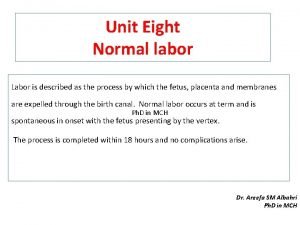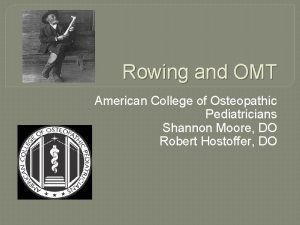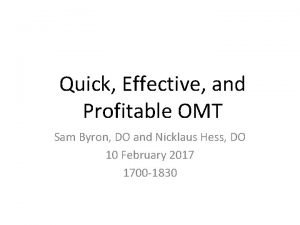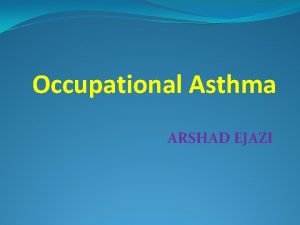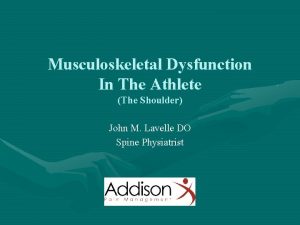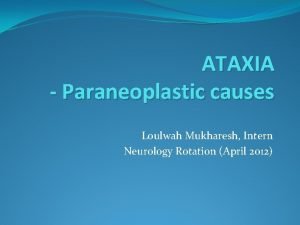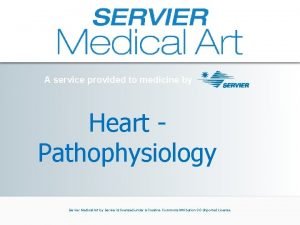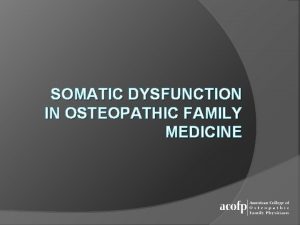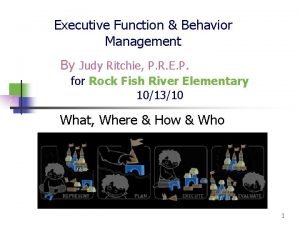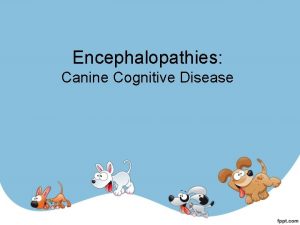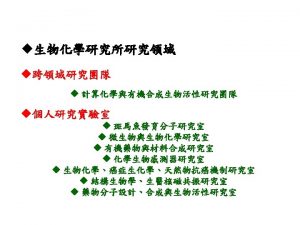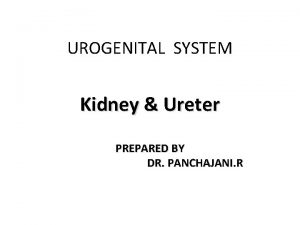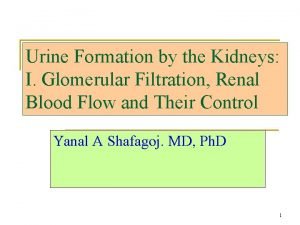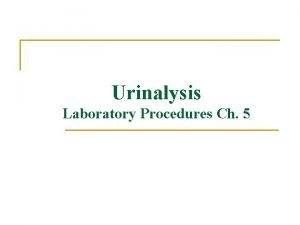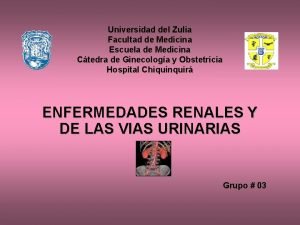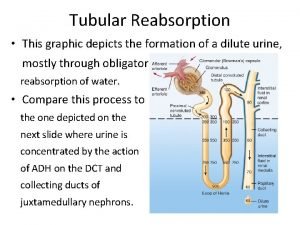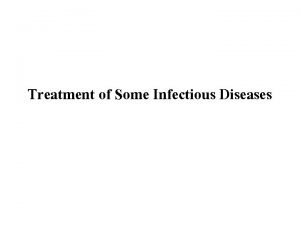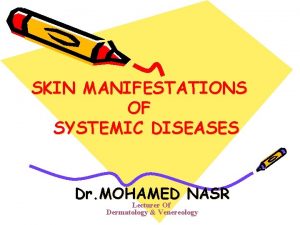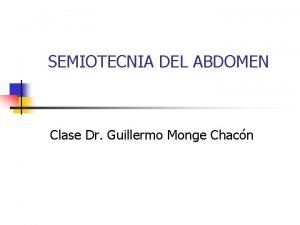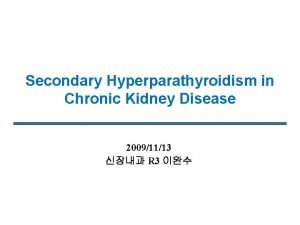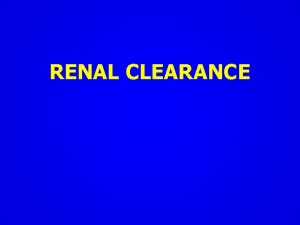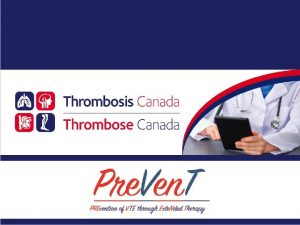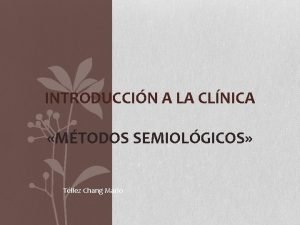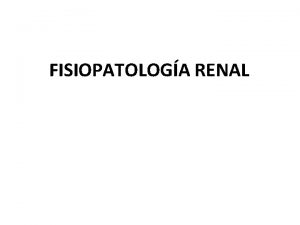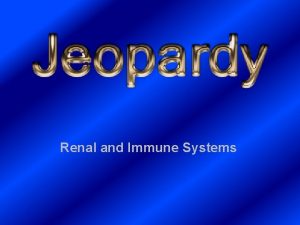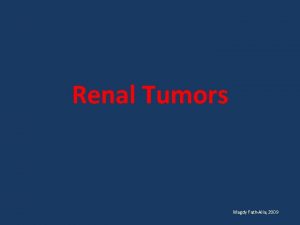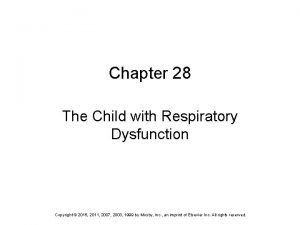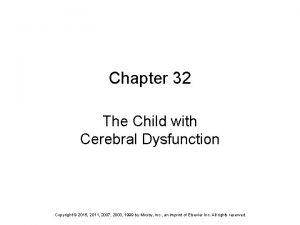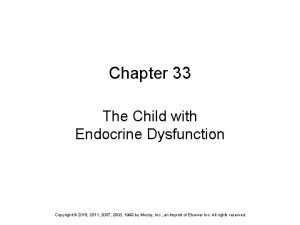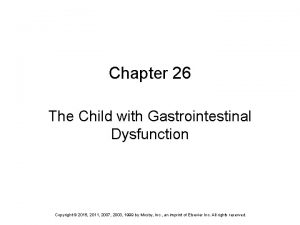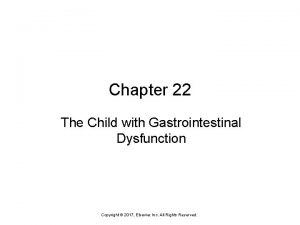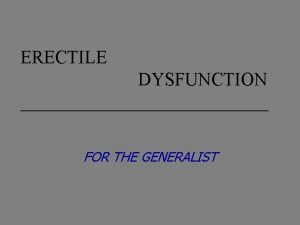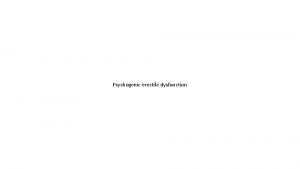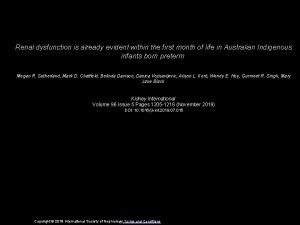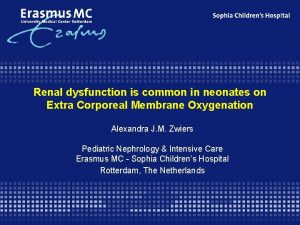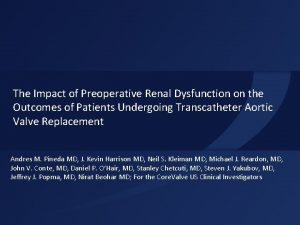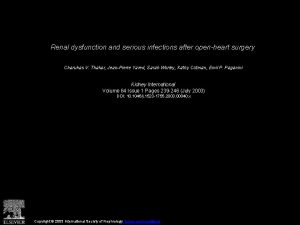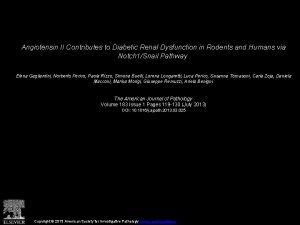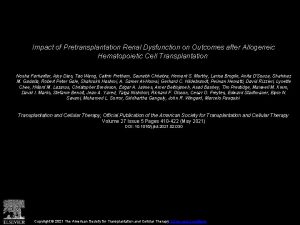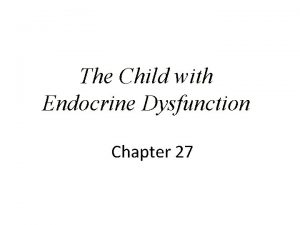Chapter 25 The Child with Renal Dysfunction Copyright



















































































- Slides: 83

Chapter 25 The Child with Renal Dysfunction Copyright © 2015, 2011, 2007, 2003, 1999 by Mosby, Inc. , an imprint of Elsevier Inc. All rights reserved.

Renal Structure and Function Primary responsibility of kidney is to maintain the composition and volume of the body fluids in equilibrium Copyright © 2015, 2011, 2007, 2003, 1999 by Mosby, Inc. , an imprint of Elsevier Inc. All rights reserved. 2

Nephron Components Copyright © 2015, 2011, 2007, 2003, 1999 by Mosby, Inc. , an imprint of Elsevier Inc. All rights reserved. 3

Case Study A nursing student is caring for a 24 -month-old pediatric patient admitted with a possible recurrent urinary tract infection. Rule out obstructive uropathy. The student in preparing for the clinical day reads about possible tests, lab values, and the management of urinary tract infections in the pediatric population. In addition, the patient’s family has asked the nursing student what renal failure means because they overheard some nurses talking about it the previous night. Copyright © 2015, 2011, 2007, 2003, 1999 by Mosby, Inc. , an imprint of Elsevier Inc. All rights reserved. 4

Renal Development and Function in Infancy Glomerular filtration and absorption low in infancy until age 1 -2 Newborn is unable to concentrate urine effectively Newborn unable to reabsorb sodium and water Newborn produces very dilute urine Copyright © 2015, 2011, 2007, 2003, 1999 by Mosby, Inc. , an imprint of Elsevier Inc. All rights reserved. 5

Renal System Assessment Physical assessment Ø Palpation, percussion Health history Previous UTIs, calculi, stasis, retention, pregnancy, STDs, bladder cancer Ø Medications: antibiotics, anticholinergics, antispasmodics Ø Urologic instrumentation Ø Urinary hygiene Ø Patterns of elimination Ø Copyright © 2015, 2011, 2007, 2003, 1999 by Mosby, Inc. , an imprint of Elsevier Inc. All rights reserved. 6

GENITOURINARY TRACT DISORDERS Copyright © 2015, 2011, 2007, 2003, 1999 by Mosby, Inc. , an imprint of Elsevier Inc. All rights reserved. 7

Urinary Tract Infection Nursing Assessment Nausea, vomiting, anorexia, chills, nocturia, urinary frequency, urgency Suprapubic or lower back pain, bladder spasms, dysuria, burning on urination Copyright © 2015, 2011, 2007, 2003, 1999 by Mosby, Inc. , an imprint of Elsevier Inc. All rights reserved. 8

Urinary Tract Infection Nursing Assessment (Cont. ) Objective data Fever Hematuria; foul-smelling urine; tender, enlarged kidney Ø Leukocytosis, positive findings for bacteria, WBCs, RBCs, pyuria, ultrasound, CT scan, IVP Ø Ø Copyright © 2015, 2011, 2007, 2003, 1999 by Mosby, Inc. , an imprint of Elsevier Inc. All rights reserved. 9

Diagnostic Studies UA Urine C&S BUN Creatinine KUB IVP VCG/VCUG Renal scan Cystogram Retrograde pyelogram Ultrasound CT MRI Renal arteriogram Copyright © 2015, 2011, 2007, 2003, 1999 by Mosby, Inc. , an imprint of Elsevier Inc. All rights reserved. 10

Normal Urinalysis p. H 5 to 9 Specific gravity 1. 001 to 1. 035 Protein <20 mg/dl Urobilinogen up to 1 mg/dl None of the following: Ø Ø Glucose Ketones Hgb WBCs Ø Ø Ø RBCs Casts Nitrites Copyright © 2015, 2011, 2007, 2003, 1999 by Mosby, Inc. , an imprint of Elsevier Inc. All rights reserved. 11

Normal Characteristics of Urine Color range Clear Newborn production about 1 to 2 ml/kg/hr Child production about 1 ml/kg/hr Copyright © 2015, 2011, 2007, 2003, 1999 by Mosby, Inc. , an imprint of Elsevier Inc. All rights reserved. 12

Urinary Tract Infection (UTI) Is it really that serious? Concept of “asymptomatic bacteria” in urinary tract Copyright © 2015, 2011, 2007, 2003, 1999 by Mosby, Inc. , an imprint of Elsevier Inc. All rights reserved. 13

Case Study 1. When observing manifestations of a urinary tract infection in the 24 -month old, what might the student nurse expect to see? Select all that apply. A. B. C. D. E. F. Painful urination Poor feedings Frequent urination Not thirsty Fever Foul-smelling urine Copyright © 2015, 2011, 2007, 2003, 1999 by Mosby, Inc. , an imprint of Elsevier Inc. All rights reserved. 14

UTIs—Causes Escherichia coli most common pathogen Streptococci Staphylococcus saprophyticus Occasionally fungal and parasitic pathogens Copyright © 2015, 2011, 2007, 2003, 1999 by Mosby, Inc. , an imprint of Elsevier Inc. All rights reserved. 15

UTIs Classification Upper tract involves renal parenchyma, pelvis, and ureters Ø Typically causes fever, chills, flank pain Lower tract involves lower urinary tract Ø Usually no systemic manifestations Copyright © 2015, 2011, 2007, 2003, 1999 by Mosby, Inc. , an imprint of Elsevier Inc. All rights reserved. 16

UTIs Classification (Cont. ) Lower tract Ø Ø Cystitis Urethritis Upper tract Ø Ø Ø Pyelonephritis VUR Glomerulonephritis Copyright © 2015, 2011, 2007, 2003, 1999 by Mosby, Inc. , an imprint of Elsevier Inc. All rights reserved. 17

UTI Classification (Cont. ) Uncomplicated infection Complicated infections Ø Ø Ø Stones Obstruction Catheters Diabetes or neurologic disease Recurrent infections Copyright © 2015, 2011, 2007, 2003, 1999 by Mosby, Inc. , an imprint of Elsevier Inc. All rights reserved. 18

Types of UTIs Recurrent—repeated episodes Persistent—bacteriuria despite antibiotics Febrile—typically indicates pyelonephritis Urosepsis—bacterial illness; urinary pathogens in blood Copyright © 2015, 2011, 2007, 2003, 1999 by Mosby, Inc. , an imprint of Elsevier Inc. All rights reserved. 19

UTIs Etiology and Pathophysiology Physiologic and mechanical defense mechanisms maintain sterility Ø Ø Emptying bladder Normal antibacterial properties of urine and tract Ureterovesical junction competence Peristaltic activity Copyright © 2015, 2011, 2007, 2003, 1999 by Mosby, Inc. , an imprint of Elsevier Inc. All rights reserved. 20

Case Study (Cont. ) 2. The single most important host factor influencing the occurrence of a urinary tract infection is? A. Urethra B. Urinary stasis C. Uric acid D. Urination Copyright © 2015, 2011, 2007, 2003, 1999 by Mosby, Inc. , an imprint of Elsevier Inc. All rights reserved. 21

UTIs Etiology and Pathophysiology (Cont. ) Alteration of defense mechanisms increases risk of UTIs Organisms usually introduced via ascending route from urethra Less common routes Ø Ø Bloodstream Lymphatic system Copyright © 2015, 2011, 2007, 2003, 1999 by Mosby, Inc. , an imprint of Elsevier Inc. All rights reserved. 22

UTIs Etiology and Pathophysiology (Cont. ) Contributing factor—urologic instrumentation Ø Allows bacteria present in opening of urethra to enter urethra or bladder Sexual intercourse promotes “milking” of bacteria from perineum and vagina Ø May cause minor urethral trauma Copyright © 2015, 2011, 2007, 2003, 1999 by Mosby, Inc. , an imprint of Elsevier Inc. All rights reserved. 23

UTIs Etiology and Pathophysiology (Cont. ) UTIs rarely result from hematogenous route For kidney infection to occur from hematogenous transmission, must have prior injury to urinary tract Ø Ø Ø Obstruction of ureter Damage from stones Renal scars Copyright © 2015, 2011, 2007, 2003, 1999 by Mosby, Inc. , an imprint of Elsevier Inc. All rights reserved. 24

UTIs Etiology and Pathophysiology (Cont. ) A UTI is a common nosocomial infection Ø Ø Often Escherichia coli Seldom Pseudomonas Urologic instrumentation is a common predisposing factor Copyright © 2015, 2011, 2007, 2003, 1999 by Mosby, Inc. , an imprint of Elsevier Inc. All rights reserved. 25

UTIs Clinical Manifestations Symptoms Ø Ø Dysuria Frequent urination (>q 2 h) Urgency Suprapubic discomfort or pressure Copyright © 2015, 2011, 2007, 2003, 1999 by Mosby, Inc. , an imprint of Elsevier Inc. All rights reserved. 26

UTIs Clinical Manifestations (Cont. ) Urine may contain visible blood or sediment (cloudy appearance) Flank pain, chills, and fever indicate infection of upper tract (pyelonephritis) Copyright © 2015, 2011, 2007, 2003, 1999 by Mosby, Inc. , an imprint of Elsevier Inc. All rights reserved. 27

UTIs Clinical Manifestations (Cont. ) Pediatric patients with significant bacteriuria may have no symptoms or nonspecific symptoms like fatigue or anorexia Copyright © 2015, 2011, 2007, 2003, 1999 by Mosby, Inc. , an imprint of Elsevier Inc. All rights reserved. 28

Pediatric Manifestations Frequency Fever in some cases Odiferous urine Blood or blood-tinged urine Sometimes no symptoms except generalized sepsis Copyright © 2015, 2011, 2007, 2003, 1999 by Mosby, Inc. , an imprint of Elsevier Inc. All rights reserved. 29

UTIs Diagnostic Studies Dipstick Microscopic urinalysis Culture Copyright © 2015, 2011, 2007, 2003, 1999 by Mosby, Inc. , an imprint of Elsevier Inc. All rights reserved. 30

UTIs Diagnostic Studies (Cont. ) Clean-catch is preferred U-bag for collection from child Specimen obtained by catheterization or suprapubic needle aspiration has more accurate results Ø May be necessary when clean-catch cannot be obtained Copyright © 2015, 2011, 2007, 2003, 1999 by Mosby, Inc. , an imprint of Elsevier Inc. All rights reserved. 31

UTIs Diagnostic Studies (Cont. ) Sensitivity testing determines susceptibility to antibiotics Imaging studies for suspected obstruction Ø IVP or abdominal CT Copyright © 2015, 2011, 2007, 2003, 1999 by Mosby, Inc. , an imprint of Elsevier Inc. All rights reserved. 32

UTI Collaborative Care Drug Therapy —Antibiotics Uncomplicated cystitis—short-term course of antibiotics Complicated UTIs—long-term treatment Trimethoprim-sulfamethoxazole (TMP-SMX) or nitrofurantoin Amoxicillin Copyright © 2015, 2011, 2007, 2003, 1999 by Mosby, Inc. , an imprint of Elsevier Inc. All rights reserved. 33

UTI Collaborative Care Drug Therapy (Cont. ) Cephalexin Others Ø Gentamycin, carbenicillin++ Pyridium (OTC) Combination agents (e. g. , Urised) used to relieve pain Ø Preparations with methylene blue tint Copyright © 2015, 2011, 2007, 2003, 1999 by Mosby, Inc. , an imprint of Elsevier Inc. All rights reserved. 34

UTI Collaborative Care Drug Therapy for Repeated UTIs Prophylactic or suppressive antibiotics TMP-SMX administered every day to prevent recurrence or single dose before events likely to cause UTI Copyright © 2015, 2011, 2007, 2003, 1999 by Mosby, Inc. , an imprint of Elsevier Inc. All rights reserved. 35

Vesicoureteral Reflux (VUR) Retrograde flow of bladder urine into the ureters Increases potential for infection Primary vs. secondary reflux Grades of reflux Copyright © 2015, 2011, 2007, 2003, 1999 by Mosby, Inc. , an imprint of Elsevier Inc. All rights reserved. 36

Acute Pyelonephritis—Etiology and Pathophysiology Inflammation caused by bacteria, fungi, protozoa, or viruses infecting kidneys Urosepsis—systemic infection from urologic source Ø Can lead to septic shock and death in 15% of cases Copyright © 2015, 2011, 2007, 2003, 1999 by Mosby, Inc. , an imprint of Elsevier Inc. All rights reserved. 37

GLOMERULAR DISEASE Copyright © 2015, 2011, 2007, 2003, 1999 by Mosby, Inc. , an imprint of Elsevier Inc. All rights reserved. 38

Acute Glomerulonephritis May be primary event or evidence of systemic disorder Range from minimal to severe Common features Oliguria, edema, hypertension, and circulatory congestion Ø Hematuria Ø Proteinuria Ø Copyright © 2015, 2011, 2007, 2003, 1999 by Mosby, Inc. , an imprint of Elsevier Inc. All rights reserved. 39

Glomerulonephritis Symptoms Generalized edema due to decreased glomerular filtration Ø Ø Begins with periorbital Progresses to lower extremities and then to ascites HTN due to increased ECF Copyright © 2015, 2011, 2007, 2003, 1999 by Mosby, Inc. , an imprint of Elsevier Inc. All rights reserved. 40

Types of Glomerulonephritis Most are postinfectious Ø Pneumococcal, streptococcal, or viral May be distinct entity or May be a manifestation of a systemic disorder Ø Ø Ø SLE Sickle cell disease Others Copyright © 2015, 2011, 2007, 2003, 1999 by Mosby, Inc. , an imprint of Elsevier Inc. All rights reserved. 41

Glomerulonephritis Symptoms (Cont. ) Oliguria Hematuria Ø Bleeding in upper urinary tract → smoky urine Proteinuria Ø Increased amount of protein = increase in severity of renal disease Copyright © 2015, 2011, 2007, 2003, 1999 by Mosby, Inc. , an imprint of Elsevier Inc. All rights reserved. 42

Acute Poststreptococcal Glomerulonephritis (APSG) Is a noninfectious renal disease (autoimmune) Onset 5 to 12 days after other type of infection Often group A β-hemolytic streptococci Most common in children 6 to 7 years old Uncommon in children younger than 2 years old Can occur at any age Copyright © 2015, 2011, 2007, 2003, 1999 by Mosby, Inc. , an imprint of Elsevier Inc. All rights reserved. 43

Prognosis 95%—rapid improvement to complete recovery 5% to 15%—chronic glomerulonephritis 1%—irreversible damage Copyright © 2015, 2011, 2007, 2003, 1999 by Mosby, Inc. , an imprint of Elsevier Inc. All rights reserved. 44

Nursing Management of APSG Manage edema Ø Ø Ø Nutrition Ø Daily weights Accurate I&O Daily abdominal girth Low sodium, low to moderate protein Susceptibility to infections Bed rest is not necessary Copyright © 2015, 2011, 2007, 2003, 1999 by Mosby, Inc. , an imprint of Elsevier Inc. All rights reserved. 45

Nephrotic Syndrome Most common presentation of glomerular injury in children Characteristics Ø Ø Ø Proteinuria Hypoalbuminemia Hyperlipidemia Edema Massive urinary protein loss Copyright © 2015, 2011, 2007, 2003, 1999 by Mosby, Inc. , an imprint of Elsevier Inc. All rights reserved. 46

Nephrotic Syndrome (Cont. ) Copyright © 2015, 2011, 2007, 2003, 1999 by Mosby, Inc. , an imprint of Elsevier Inc. All rights reserved. 47

Types of Nephrotic Syndrome Minimal change nephrotic syndrome (MCNS) Ø Also called • Idiopathic nephrosis • Nil disease • Uncomplicated nephrosis • Childhood nephrosis • Minimal lesion nephrosis Congenital nephrotic syndrome Secondary nephrotic syndrome Copyright © 2015, 2011, 2007, 2003, 1999 by Mosby, Inc. , an imprint of Elsevier Inc. All rights reserved. 48

Changes in Nephrotic Syndrome Glomerular membrane Normally impermeable to large proteins Becomes permeable to proteins, especially albumin Ø Albumin lost in urine (hyperalbuminuria) Ø Serum albumin decreases (hypoalbuminemia) Ø Fluid shifts from plasma to interstitial spaces • Hypovolemia • Ascites Ø Ø Copyright © 2015, 2011, 2007, 2003, 1999 by Mosby, Inc. , an imprint of Elsevier Inc. All rights reserved. 49

Nephrotic Syndrome (Cont. ) “Edema” phase “Remission” phase Prognosis Copyright © 2015, 2011, 2007, 2003, 1999 by Mosby, Inc. , an imprint of Elsevier Inc. All rights reserved. 50

Nephrotic Syndrome Management Supportive care Diet Ø Ø Steroids Ø Ø Low to moderate protein Sodium restrictions if large amount of edema 2 mg/kg divided into BID doses Prednisone drug of choice (cheapest and safest) Immunosuppressant therapy (Cytoxan) Diuretics Copyright © 2015, 2011, 2007, 2003, 1999 by Mosby, Inc. , an imprint of Elsevier Inc. All rights reserved. 51

Family Issues Chronic condition with relapses Developmental milestones Social isolation Ø Ø Ø Lack of energy Immunosuppression/protection Change in appearance due to edema—self-image Copyright © 2015, 2011, 2007, 2003, 1999 by Mosby, Inc. , an imprint of Elsevier Inc. All rights reserved. 52

Nursing Interventions Aseptic technique during catheterizations Avoid unnecessary catheterization and early removal of indwelling catheters Ø Prevents nosocomial infections Wash hands before and after contact Wear gloves for care of urinary system Copyright © 2015, 2011, 2007, 2003, 1999 by Mosby, Inc. , an imprint of Elsevier Inc. All rights reserved. 53

Nursing Interventions (Cont. ) Routine and thorough perineal care for all hospitalized patients Avoid incontinent episodes by answering call light and offering bedpan at frequent intervals Copyright © 2015, 2011, 2007, 2003, 1999 by Mosby, Inc. , an imprint of Elsevier Inc. All rights reserved. 54

Nursing Interventions (Cont. ) Ensure adequate fluid intake (patients with urinary problems may think fluid intake will make them more uncomfortable) Ø Ø Ø Dilutes urine, making bladder less irritable Flushes out bacteria before they can colonize Avoid caffeine, alcohol, citrus juices, chocolate, and highly spiced foods • Potential bladder irritants Copyright © 2015, 2011, 2007, 2003, 1999 by Mosby, Inc. , an imprint of Elsevier Inc. All rights reserved. 55

Nursing Interventions (Cont. ) Discharge to home instructions Follow-up urine culture Recurrent symptoms typically occur in 1 to 2 weeks after therapy Ø Encourage adequate fluids even after infection Ø Low-dose, long-term antibiotics to prevent relapses or reinfections Ø Explain rationale to enhance compliance Ø Copyright © 2015, 2011, 2007, 2003, 1999 by Mosby, Inc. , an imprint of Elsevier Inc. All rights reserved. 56

Renal Tubular Disorders Renal tubular acidosis Proximal tubular acidosis (type II) Distal tubular acidosis (type I) Copyright © 2015, 2011, 2007, 2003, 1999 by Mosby, Inc. , an imprint of Elsevier Inc. All rights reserved. 57

Nephrogenic Diabetes Insipidus (NDI) Major disorder associated with a defect in ability to concentrate urine Distal tubules and collecting ducts are insensitive to action of ADH (vasopressin) X-linked recessive inheritance Copyright © 2015, 2011, 2007, 2003, 1999 by Mosby, Inc. , an imprint of Elsevier Inc. All rights reserved. 58

Clinical Manifestations of Diabetes Insipidus Newborn—vomiting, fever, failure to thrive, hypernatremia Copious amounts of dilute urine Growth retardation Copyright © 2015, 2011, 2007, 2003, 1999 by Mosby, Inc. , an imprint of Elsevier Inc. All rights reserved. 59

Therapeutic Management Fluid management (management of extreme thirst in child) Pharmacologic interventions Copyright © 2015, 2011, 2007, 2003, 1999 by Mosby, Inc. , an imprint of Elsevier Inc. All rights reserved. 60

MISCELLANEOUS RENAL DISORDERS Copyright © 2015, 2011, 2007, 2003, 1999 by Mosby, Inc. , an imprint of Elsevier Inc. All rights reserved. 61

Hemolytic-Uremic Syndrome Pathophysiology Diagnostic evaluation Therapeutic management Prognosis Nursing considerations Copyright © 2015, 2011, 2007, 2003, 1999 by Mosby, Inc. , an imprint of Elsevier Inc. All rights reserved. 62

Familial Nephritis (Alport Syndrome) Chronic hereditary glomerulopathy Hematuria, high-frequency deafness, ocular disorders, and chronic renal failure Ø Generally is an X-linked dominant trait Ø Copyright © 2015, 2011, 2007, 2003, 1999 by Mosby, Inc. , an imprint of Elsevier Inc. All rights reserved. 63

Unexplained Proteinuria Transient proteinuria Persistent proteinuria Orthostatic proteinuria Importance of excluding renal disease with diagnostic tests Copyright © 2015, 2011, 2007, 2003, 1999 by Mosby, Inc. , an imprint of Elsevier Inc. All rights reserved. 64

Renal Trauma Kidneys in children are mobile than in adults, and the outer borders of kidneys of children are less well protected Injuries usually blunt trauma Ø Falls, sports injuries, motor vehicle crashes Copyright © 2015, 2011, 2007, 2003, 1999 by Mosby, Inc. , an imprint of Elsevier Inc. All rights reserved. 65

Renal Failure Acute renal failure (ARF) Chronic renal failure (CRF) Copyright © 2015, 2011, 2007, 2003, 1999 by Mosby, Inc. , an imprint of Elsevier Inc. All rights reserved. 66

Acute Renal Failure (ARF) Definition—kidneys suddenly unable to regulate the volume and composition of urine Not common in children Principal feature is oliguria Ø Associated with azotemia, metabolic acidosis, and electrolyte disturbances Most common pathologic cause—transient renal failure resulting from severe dehydration Copyright © 2015, 2011, 2007, 2003, 1999 by Mosby, Inc. , an imprint of Elsevier Inc. All rights reserved. 67

ARF (Cont. ) Pathophysiology—usually reversible Diagnostic evaluation Therapeutic management Nursing considerations Copyright © 2015, 2011, 2007, 2003, 1999 by Mosby, Inc. , an imprint of Elsevier Inc. All rights reserved. 68

Complications of ARF Hyperkalemia Hypertension Anemia Seizures Hypervolemia Cardiac failure with pulmonary edema Copyright © 2015, 2011, 2007, 2003, 1999 by Mosby, Inc. , an imprint of Elsevier Inc. All rights reserved. 69

Case Study (Cont. ) 3. If a child who is dehydrated, is in shock, or has recently undergone surgery develops diminished urinary output and lethargy, the child should be evaluated for possible: A. B. C. D. Acute renal failure Chronic renal failure Obstructive uropathy Wilm’s tumor Copyright © 2015, 2011, 2007, 2003, 1999 by Mosby, Inc. , an imprint of Elsevier Inc. All rights reserved. 70

Chronic Renal Failure (CRF) Begins when diseased kidneys cannot maintain normal chemical structure of body fluids Clinical syndrome called uremia Copyright © 2015, 2011, 2007, 2003, 1999 by Mosby, Inc. , an imprint of Elsevier Inc. All rights reserved. 71

Potential Causes of CRF Congenital renal and urinary tract malformations VUR associated with recurrent UTIs Chronic pyelonephritis Chronic glomerulonephritis Copyright © 2015, 2011, 2007, 2003, 1999 by Mosby, Inc. , an imprint of Elsevier Inc. All rights reserved. 72

CRF Pathophysiology Diagnostic evaluation Therapeutic management Ø Manage diet, hypertension, recurrent infections, seizures Nursing considerations Copyright © 2015, 2011, 2007, 2003, 1999 by Mosby, Inc. , an imprint of Elsevier Inc. All rights reserved. 73

Renal Replacement Therapy Dialysis types Ø Ø Ø Hemodialysis Peritoneal dialysis Hemofiltration Copyright © 2015, 2011, 2007, 2003, 1999 by Mosby, Inc. , an imprint of Elsevier Inc. All rights reserved. 74

Hemodialysis Requires creation of a vascular access and special dialysis equipment Best suited for children who can be brought to facility 3 times per week for 4 to 6 hours Achieves rapid correction of fluid and electrolyte abnormalities Copyright © 2015, 2011, 2007, 2003, 1999 by Mosby, Inc. , an imprint of Elsevier Inc. All rights reserved. 75

Child Receiving Hemodialysis Copyright © 2015, 2011, 2007, 2003, 1999 by Mosby, Inc. , an imprint of Elsevier Inc. All rights reserved. 76

Peritoneal Dialysis Abdominal cavity acts as semipermeable membrane for filtration Can be managed at home in some cases Warmed solution enters peritoneal cavity by gravity; remains for period of time before removal Copyright © 2015, 2011, 2007, 2003, 1999 by Mosby, Inc. , an imprint of Elsevier Inc. All rights reserved. 77

Continuous Venovenous Hemofiltration Uses technique for ultrafiltration of blood continuously at a very slow rate Works with the fluid overload in postoperative period Successful alternative for critically ill children who might not survive rapid volume changes of hemodialysis and/or PD Copyright © 2015, 2011, 2007, 2003, 1999 by Mosby, Inc. , an imprint of Elsevier Inc. All rights reserved. 78

Transplantation From living, related donor From cadaver donor Primary goal is long-term survival of grafted tissue Role of immunosuppressant therapy Rejection Prognosis Copyright © 2015, 2011, 2007, 2003, 1999 by Mosby, Inc. , an imprint of Elsevier Inc. All rights reserved. 79

Defects of the Genitourinary Tract Phimosis Hydrocele Cryptorchidism Hypospadias Epispadias and exstrophy complex Obstructive uropathy Copyright © 2015, 2011, 2007, 2003, 1999 by Mosby, Inc. , an imprint of Elsevier Inc. All rights reserved. 80

Hypospadias Urethral opening is located below the glans penis or anywhere along the underside of the penile shaft Requires surgical correction Nursing assessment of every male newborn Copyright © 2015, 2011, 2007, 2003, 1999 by Mosby, Inc. , an imprint of Elsevier Inc. All rights reserved. 81

Hypospadias Copyright © 2015, 2011, 2007, 2003, 1999 by Mosby, Inc. , an imprint of Elsevier Inc. All rights reserved. 82

Case Study (Cont. ) 4. The dilation of the renal pelvis from distention caused when there is interference with urine flow is called? A. B. C. D. Acute glomerulonephritis Hydronephrosis Hemolytic uremic syndrome Nephrotic syndrome Copyright © 2015, 2011, 2007, 2003, 1999 by Mosby, Inc. , an imprint of Elsevier Inc. All rights reserved. 83
 Ira pré renal renal e pós renal
Ira pré renal renal e pós renal Teoria do nefron intacto
Teoria do nefron intacto Cortical and juxtamedullary nephrons difference
Cortical and juxtamedullary nephrons difference True labor pains
True labor pains Orgasmic dysfunction
Orgasmic dysfunction Rib somatic dysfunction
Rib somatic dysfunction Sam byron
Sam byron Reactive airways dysfunction syndrome
Reactive airways dysfunction syndrome Rib somatic dysfunction
Rib somatic dysfunction True labour pain
True labour pain Conjunction dysfunction
Conjunction dysfunction What causes ataxia
What causes ataxia Spinocerebellar ataxia
Spinocerebellar ataxia Dysfunction merton
Dysfunction merton Diastolic dysfunction echocardiography
Diastolic dysfunction echocardiography Systolic and diastolic dysfunction
Systolic and diastolic dysfunction Somatic dysfunction in osteopathic family medicine
Somatic dysfunction in osteopathic family medicine Pelvic floor dysfunction
Pelvic floor dysfunction Judy ritchie
Judy ritchie Canine cognitive dysfunction
Canine cognitive dysfunction Breathing pattern dysfunction
Breathing pattern dysfunction North dakota null hypothesis brain inventory
North dakota null hypothesis brain inventory Left child right sibling tree
Left child right sibling tree Hát kết hợp bộ gõ cơ thể
Hát kết hợp bộ gõ cơ thể Lp html
Lp html Bổ thể
Bổ thể Tỉ lệ cơ thể trẻ em
Tỉ lệ cơ thể trẻ em Chó sói
Chó sói Chụp phim tư thế worms-breton
Chụp phim tư thế worms-breton Bài hát chúa yêu trần thế alleluia
Bài hát chúa yêu trần thế alleluia Các môn thể thao bắt đầu bằng tiếng chạy
Các môn thể thao bắt đầu bằng tiếng chạy Thế nào là hệ số cao nhất
Thế nào là hệ số cao nhất Các châu lục và đại dương trên thế giới
Các châu lục và đại dương trên thế giới Công của trọng lực
Công của trọng lực Trời xanh đây là của chúng ta thể thơ
Trời xanh đây là của chúng ta thể thơ Mật thư tọa độ 5x5
Mật thư tọa độ 5x5 Làm thế nào để 102-1=99
Làm thế nào để 102-1=99 Phản ứng thế ankan
Phản ứng thế ankan Các châu lục và đại dương trên thế giới
Các châu lục và đại dương trên thế giới Thơ thất ngôn tứ tuyệt đường luật
Thơ thất ngôn tứ tuyệt đường luật Quá trình desamine hóa có thể tạo ra
Quá trình desamine hóa có thể tạo ra Một số thể thơ truyền thống
Một số thể thơ truyền thống Bàn tay mà dây bẩn
Bàn tay mà dây bẩn Vẽ hình chiếu vuông góc của vật thể sau
Vẽ hình chiếu vuông góc của vật thể sau Biện pháp chống mỏi cơ
Biện pháp chống mỏi cơ đặc điểm cơ thể của người tối cổ
đặc điểm cơ thể của người tối cổ V cc
V cc Vẽ hình chiếu đứng bằng cạnh của vật thể
Vẽ hình chiếu đứng bằng cạnh của vật thể Tia chieu sa te
Tia chieu sa te Thẻ vin
Thẻ vin đại từ thay thế
đại từ thay thế điện thế nghỉ
điện thế nghỉ Tư thế ngồi viết
Tư thế ngồi viết Diễn thế sinh thái là
Diễn thế sinh thái là Dot
Dot Số nguyên là gì
Số nguyên là gì Tư thế ngồi viết
Tư thế ngồi viết Lời thề hippocrates
Lời thề hippocrates Thiếu nhi thế giới liên hoan
Thiếu nhi thế giới liên hoan ưu thế lai là gì
ưu thế lai là gì Sự nuôi và dạy con của hổ
Sự nuôi và dạy con của hổ Khi nào hổ mẹ dạy hổ con săn mồi
Khi nào hổ mẹ dạy hổ con săn mồi Hệ hô hấp
Hệ hô hấp Từ ngữ thể hiện lòng nhân hậu
Từ ngữ thể hiện lòng nhân hậu Thế nào là mạng điện lắp đặt kiểu nổi
Thế nào là mạng điện lắp đặt kiểu nổi Renal medulla
Renal medulla Bristolian douglas rys
Bristolian douglas rys Perinephric abscess symptoms
Perinephric abscess symptoms Glomerular capillary pressure
Glomerular capillary pressure Urolith
Urolith Signo de puño percusion renal
Signo de puño percusion renal Renal cell carcinoma
Renal cell carcinoma Tubular reabsorption
Tubular reabsorption Lamivudine renal dose
Lamivudine renal dose Peritubular capillaries in kidney
Peritubular capillaries in kidney Earthy look in chronic renal failure
Earthy look in chronic renal failure Maniobra de middleton
Maniobra de middleton Approach to hyperparathyroidism
Approach to hyperparathyroidism Renal clearance formula
Renal clearance formula Clearance equation renal
Clearance equation renal Renal
Renal Lovenox renal dosing
Lovenox renal dosing Urinalysis
Urinalysis Puño percusion positiva
Puño percusion positiva



